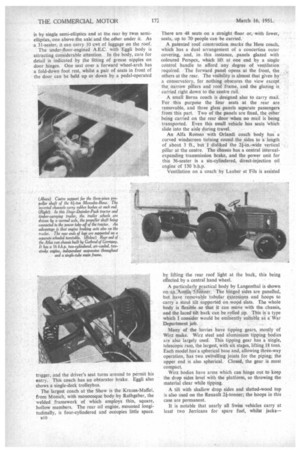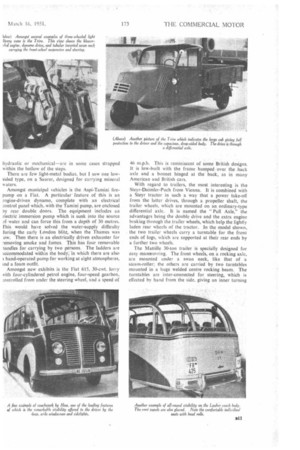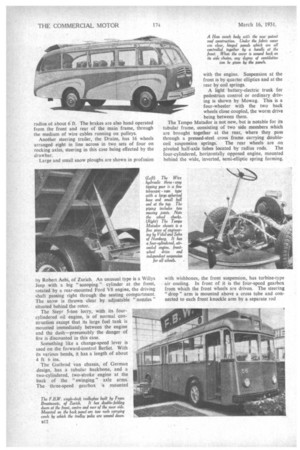CONTINE I BODYBUILDERS EXCEL
Page 42

Page 43

Page 44

Page 45

Page 46

If you've noticed an error in this article please click here to report it so we can fix it.
AVISIT to an international motor show abroad is always of interest, because where British vehicles are staged in force it affords an excellent opportunity of comparing the design of our chassis and coachwork with those from other countries. It may be that the somewhat stringent regulations obtaining in Britain would not permit here the use of certain sizes of foreign vehicles nor allow the employment of features of design which are recognized everywhere but in this country. All, however, are worth studying and, who knows, our pundits may eventually be influenced so far as to modify over-strict rules, with a view to some measure of international standardization.
I do not suggest that there are no restrictions abroad. In Switzerland alone there are limits of size and, in particular, of width, to which vehicles operating there must conform—in fact, Swiss operators are inclined to be aggrieved because visiting' coaches wider than are permitted to home users are freely admitted. No doubt this is because the Swiss must live largely upon tourist traffic.
It is appropriate that first reference should be made to a Swiss product as, although it has been shown before, it is one of the highlights. I refer to the sideengined Satirer chassis destined for service in Geneva. Already 30 or more of this type are operating in other Swiss cities, and although the critic might suggest that the weight of the big six-cylindered oil unit might upset the balance of the vehicle, I was assured that little; if any,. difference is noted, and it is, of course, on the off Side.
rr'Om a hydraulic coupling, a short shaft at 90 degrees takes the drive to the centrally disposed clutch and electrically controlled preselective gearbox in which the actual changes are carried out hydraulically. There is a fan at the back of the engine, but this serves merely to draw dust and heat from the engine case, the radiator being right forward, where there is a multi-bladed fan driven, with the dynamo,' by a five-piece shaft with six universal joints, mostly accommodated within a side member channel. This is one feature which may surprise our designers. Incidentally, few, if any, seats are lost, as the body for this chassis has a seat for five arranged longitudinally at the off side, facing the conductor, who sits at his little desk opposite. In another Saurer, with a Gangloff body, the engine is similarly arranged at the side, but right at the rear. In this case the Cover forms a platform for luggage, or, as shown, a cocktail cabinet, whilst at the rear side is p fully equipped lavatory with a dissolving chemical flush.
Points'about this fine example of bodywork are that the seat backs are adjustable for semi-reclining, the arm rests are hinged, whilst the driver's seat can tilt to facilitate entry, and its adjustment is by a hand wheel. There is an extra folding seat on the rear door, and a projection on the door fills the step gap. Spring curtains pull down over the windows and sliding curtains cover the glazed sections over the cant rails. A novelty is a Vitaglass windscreen.
Another Gangloff body on a Berna has a completely glazed roof and sides, the roof sections sliding to give ventilation, all being covered by a concertina-type hood in bad weather or excessive sun. On long trips the seats are slid sideways into the gangway in pairs, and the driver's seat slides towards the side to allow him to pass between it and the engine casing.
There are few chassisless buses, but one is the Ikarus-30, built by Technoimpex, of Budapest It is of rolled and pressed high-tensile-steel sections welded throughout, hut the inner and outer side and roof panels are of aluminium alloy, screwed into place. The fourcylindered engine is built under Steyr licence and gives 85 b.h.p., with a compression ratio of 21 to I. The five-speed gearbox is unit mounted with the engine and the divided propeller shaft is rubber suspended. A tubular, square-section welded pressing forms the front axle, whilst the pressed-steel back axle, with helical drive, is provided with a differential lock. Braking is hydraulic through an air servo. Suspension at the front is by single semi-elliptics and at the rear by twin semielliptics, one above the axle and the other under it. As a 31-seater, it can carry 10 cwt of luggage on the roof.
The under:floor-engined A.E.C. with Eggli body is attracting considerable attention. In the body, care for detail is indicated by the fitting of grease nipples on door hinges. One seat over a forward wheel-arch has a fold-down foot rest, whilst a pair of seats in front of the door can be held up or down by a pedal-operated
trigger, and the driver's seat turns around to permit his entry. This coach has an obturator brake. Egg,li also shows a single-deck trolleybus.
The largest coach at the Show is the Krauss-Maffei, from Munich, with monocoque body by Rathgeber, the welded framework of which employs thin, square, hollow members. The rear oil engine, mounted longitudinally, is four-cylindered and occupies little space.
BIO There are 48 seats on a straight floor or, with fewer, seats, up to 70 people can be carried.
A patented roof construction marks the Hess coach, which has a dual arrangement of a concertina outer covering, and, in this instance, panels glazed with coloured Perspex, which lift at one end by a single control handle to afford any degree of ventilation required. The forward panel opens at the front, the others at the rear. The visibility is almost that given by a conservatory, for nothing obscures the view except the narrow pillars and roof frame, and the glazing is carried right down to the centre rail.
A small Berna coach is designed also to carry mail. For this purpose the four seats at the rear are removable, and three glass panels separate passengers from this part. Two of the panels are fixed, the other being carried on the rear door-when no mail is being transported. Even this small vehicle has seats Which slide into the aisle during travel.
An Alfa Romeo with Orlandi coach body has a curved windscreen turning round. the sides to a length of about 3 ft., but I disliked the 21-in.-wide vertical pillar at the centre. The chassis has a central internalexpanding transmission brake, and the power unit for this 36-seater is a six-cylindered, direct-injection oil engine of 130 b.h.p.
Ventilation on a coach by Lauber et Fils is assisted by lifting the rear roof light at the back, this being effected by a central hand wheel.
A particularly_practical body by Langenthal is shown orpan..Atistut-Steliner. The hinged sides are panelled, but have removable tubular extensions and hoops to carry a stout tilt supported on wood slats. The whole body is flexible so that it can move with the chassis, mad the laced tilt back can be rolled up. This is a type which I consider would be eminently suitable as a War Department job.
Many of the lorries have tipping gears, mostly of Wirz make. Wirz steel and aluminium tipping bodies are also largely used. This tipping gear has a single, telescopic ram, the largest, with six stages, lifting 18 tons. Each model has a spherical base and, allowing three-way operation, has two swivelling joints for the piping; the upper end is also spherical. Closed, the gear is most compact.
Wirz bodies have arms which can hinge out to keep the drop sides level with the platform, so throwing the material clear while tipping.
A tilt with shallow drop sides and slatted-wood top is also used on the Renault 2i-tonner; the hoops in this case are permanent.
It is notable that nearly all Swiss vehicles carry at least two Jerricans for spare fuel, whilst jacks
hydraulic or mechanical—are in some cases strapped within the hollow of the steps.
There are few light-metal bodies, but I saw one lowsided type, on a Sauer, designed for carrying mineral waters.
Amongst municipal vehicles is the Aspi-Tamini firepump on a Fiat. A particular feature of this is an :ngine-driven dynamo, complete with an electrical control panel which, with the Tamini pump, are enclosed by rear double doors. The equipment includes an electric immersion pump which is sunk into the source 3f. water and can force this from a depth of 30 metres. This would have solved the water-supply difficulty luring the early London blitz, when the Thames was ow. Then there is an electrically driven exhauster for .emoving smoke and fumes. This has four removable aandles for carrying by two persons. The ladders are iccommodated within the body, in which there are also I hand-operated pump for working at eight atmospheres, ind a foam outfit.
Amongst new exhibits is the Fiat 615, 30-cwt. lorry with four-cylindered petrol engine, four-speed gearbox, :ontrolled from under the steering wheel, and a speed of 46 m.p.h. This is reminiscent of some British designs. It is low-built with the frame humped over the .back axle and a bonnet hinged at the back, as in many American and British cars.
With regard to trailers, the most interesting is the Steyr-Daimler-Puch from Vienna. It is combined with a Steyr tractor in such a way that a power take-off from the latter drives, through a propeller shaft, the trailer wheels, which are mounted on an ordinary-type differential axle. It is named the "Pull Axle," the advantages being the double drive and the extra engine braking through the trailer wheels, which help the lightly laden rear wheels of the tractor. In the model shown, the two trailer wheels carry a turntable for the front ends of logs, which are supported at their rear ends by a further two wheels.
The Mattille 30-ton trailer is specially designed for easy manoeuvring. The front wheels, on a rocking axle, are mounted under a swan neck, like that of a steam-roller; the others are carried by two turntables mounted in a huge welded centre rocking beam. The turntables are inter-connected for steering, which is effected by hand from the side, giving an inner turning radius of about 6 ft. The brakes are also hand operated from the front and rear of the main frame, through the medium of wire cables running on pulleys.
Another steering trailer, the Draize, has 16 wheels arranged eight in line across in two sets of four on rocking axles, steering in this case being effected by the drawbar.
Large and small snow ploughs are shown in profusion by Robert Aebi, of Zurich. An unusual type is a Willys Jeep with a big " scooping " cylinder at the front, rotated by a rear-mounted Ford V8 engine, the driving shaft passing right through the seating compartment. The snow is thrown clear by adjustable "nozzles " situated behind the rotor.
The Steyr 5-ton lorry, with its fourcylindered oil engine, is of normal construction except that its large fuel tank is mounted immediately between the engine and the dash—presumably the danger of fire is discounted in this case.
Something like a change-speed lever is used on the forward-control Berliet. With its various bends, it has a length of about 4 ft. 6 ins.
The Gutbrod van chassis, of German design, has a tubular backbone, and a two-cylindered, two-stroke engine at the back of the " swinging " axle arms. The three-speed gearbox is mounted with the engine. Suspension at the front is by quarter elliptics and at the rear by coil springs.
A light battery-electric truck for pedestrian control or ordinary driving is shown by Mowag. This is a four-wheeler with the two back wheels close coupled, the worm drive being between them.
The Tempo Matador is not new, but is notable for its tubular frame, consisting of two side members which are brought together at the rear, where they pass through a pressed-steel cross frame carrying double
coil suspension springs. The rear wheels are on pivoted half-axle tubes located by radius rods. The four-cylindered, horizontally opposed engine, mounted behind the wide, inverted, semi-elliptic spring forming.
with wishbones,. the front suspension, has turbine-type air cooling. In front of it is the four-speed gearbox from which the front wheels are driven. The steering " drop " arm is mounted above a cross tube and connected to each front knuckle arm by a separate rod




















































































